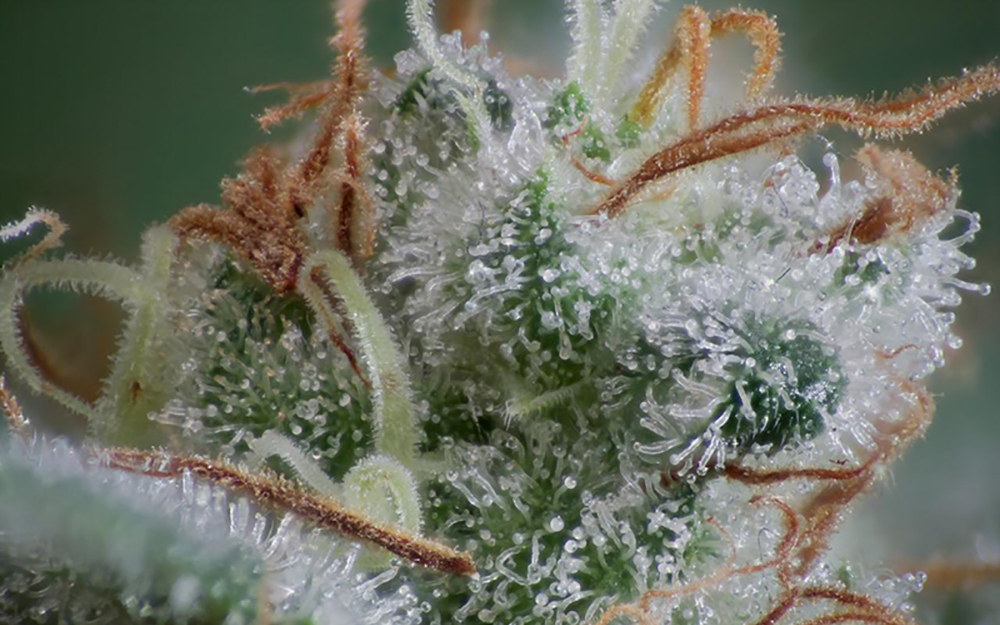
BY PATTE PURCELL
What are trichomes? Those are the sticky little crystals that cover the cannabis nuggets. Their function is vital to cannabis. They play a crucial role in its psychoactive effects. Without trichomes, we’d have no reason to consume marijuana.
These tiny “hairs” seem to be the most common indication of a healthy and potent plant. While trichomes do not always signal a successful crop, they are essential in developing top-shelf marijuana.
Although all growers know trichomes to be important, most do not understand why the cannabis plant produces them in the first place. This is crucial to grasp if you want to achieve those deliciously resinous buds. Biologically, trichomes are used for self-defence. They’re the best natural way that female cannabis plants protect themselves from pests and pathogens. With “aggressive” aromas and tastes from terpenes and other compounds secreted by trichomes, insects tend to stay away from flowers. Trichomes also help coat the buds, defending them from harmful UV rays. By providing shadows, the plant can better control the amount of light it lets into flowers.
There are two predominant factors that influence a plant’s yield and general health: genetics and environment. I can’t stress enough how crucial genetics are to start off with. If you want to achieve the best and most trichomes you can, choose genetics that are known to produce an abundance of them.
LIGHTING
This will be the most important environmental factor to consider regarding trichome development. Light exposure has a heavy influence on a plant’s trichome yield. Cannabis tends to develop more resin when grown in equatorial regions. These are areas with high exposure to UV rays. As mentioned above, cannabis uses trichomes to protect the buds from too much light. By exposing the plant to UV-B light for 2-3 weeks, you’ll be able to observe a difference in trichome yield.
LEDs might also be an option for upping trichome production. These lamps don’t produce any UV-B light, but some growers believe that with just enough stress, trichome proliferation will still increase. This might be a risky option, but it could work. When exposing your plant to low-impact forms of stress, you should constantly check for signs that they are still healthy. While some stress can be beneficial for boosting trichomes, too much will bring your plants past the point of no return.
HARVESTING AT THE RIGHT TIME
For the best yields, it’s crucial that you know how to identify when it’s time to harvest by the colour of the trichomes. This is something you should start doing in the last couple weeks of the flowering stage.
Since trichomes cannot be seen by the naked eye, they must be looked at with a magnifying glass or jeweler’s loupe. If the trichomes are still translucent, they are not ready. At this point, they’re still producing cannabinoids, something you don’t want to interrupt. Buds will grow exponentially in the last 2 weeks, so be patient. When trichomes start turning milky white, it’s an indication they’re close. The buds still won’t be ready, but this is the time to be most attentive. Around half of the pistils should’ve darkened to an amber-brown colour by now.
The trichomes will transition from a milky white to a cloudy white tonality. Harvesting during this stage will give the most psychedelic/mental effects, but it will yield less hash than if you wait. It all depends on the grower’s preference. When trichomes finally start to turn amber, there’s no more time to waste. Harvesting during this stage will create more of a body high associated with indica strains.
There is a short, yet manageable window to achieve a good mental and physical high combination. When the trichomes still display a cloudy white colour, but are already turning slightly amber, harvesting will result in a nice mix of effects. A good time to chop is when ¼ of the trichomes have turned amber, while the others remain cloudy.
OTHER FACTORS YOU SHOULD CONSIDER
Humidity and temperature can also alter the trichome yield of a cannabis plant. With the right combination of these, you can simulate a more stressful environment where the plant believes it should increase trichome production. In the last 2-3 weeks of flowering (around the same time you should increase UV-B exposure), toggling humidity and temperature will be key. Try decreasing the relative humidity (RH) levels to around 30%. Some very resinous plants grow in the Middle East where the weather is quite dry and arid.
Although, this being the case, your temperature should not surpass 80°F. Having higher temperatures won’t affect your trichome yield, but it will ruin their potency. That’s something you definitely don’t want. To verify that temperatures are correct, give your buds a good smell. If you encounter a very pungent aroma, it might be an indication the temperature is too high. This will gradually degrade your trichomes, so be careful.
Routine checks are necessary for growers of all experience levels. Always monitor your plants for any nutrient deficiencies. Nutrient uptake will seriously contribute to your frosty buds and the overall health of the plant. Even factors like airflow and proper watering practices are essential concerns for proper trichome development.
You’ll have to put in the work if you want a healthy, resinous, and potent plant. It’s not going to be easy, but hopefully this is something you truly love and take pride in doing. Be sure to show your care when harvest season comes along. Take all of the above into consideration when you plant. Just remember, “where there’s a will, there’s a way.” Good luck with your next crop!
Patte Purcell
Muze Muzic
pattepurcell@yahoo.com
1-702-219-6777










































